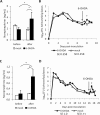6-hydroxydopamine-mediated release of norepinephrine increases faecal excretion of Salmonella enterica serovar Typhimurium in pigs
- PMID: 20609329
- PMCID: PMC2913729
- DOI: 10.1051/vetres/2010040
6-hydroxydopamine-mediated release of norepinephrine increases faecal excretion of Salmonella enterica serovar Typhimurium in pigs
Abstract
Salmonella enterica serovar Typhimurium is an animal and zoonotic pathogen of worldwide importance. In pigs, transport and social stress are associated with reactivation and spread of Salmonella Typhimurium infection. The stress-related catecholamine norepinephrine (NE) has been reported to activate growth and virulence factor expression in Salmonella; however the extent to which NE contributes to stress-associated salmonellosis is unclear. We studied the impact of releasing NE from endogenous stores during Salmonella Typhimurium infection of pigs by administration of 6-hydroxydopamine (6-OHDA), which selectively destroys noradrenergic nerve terminals. Treatment of pigs with 6-OHDA 7 or 16 days post-oral inoculation with Salmonella Typhimurium produced elevated plasma NE levels and transiently, but significantly, increased faecal excretion of the challenge strain. Oral administration of NE to Salmonella Typhimurium-infected pigs also transiently and significantly increased shedding; however pre-culture of the bacteria with NE did not alter the outcome of infection. Salmonella has been proposed to sense and respond to NE via a homologue of the adrenergic sensor kinase QseC. A DeltaqseC mutant of Salmonella Typhimurium was consistently excreted in lower numbers than the parent strain post-oral inoculation of pigs, though not significantly so. 6-OHDA treatment of pigs infected with the DeltaqseC mutant also increased faecal excretion of the mutant strain, albeit to a lesser extent than observed upon 6-OHDA treatment of pigs infected with the parent strain. Our data support the notion that stress-related catecholamines modulate the interaction of enteric bacterial pathogens with their hosts.
© The authors, published by INRA/EDP Sciences, 2010.
Figures




References
-
- Anonymous, Zoonoses Report, United Kingdom 2008, Department for Environment, Food and Rural Affairs Publications, London, 2010
-
- Bearson B.L., Bearson S.M., The role of the QseC quorum-sensing sensor kinase in colonization and norepinephrine-enhanced motility of Salmonella enterica serovar Typhimurium, Microb. Pathog. (2008) 44:271–278 - PubMed
Publication types
MeSH terms
Substances
Grants and funding
LinkOut - more resources
Full Text Sources
Medical
